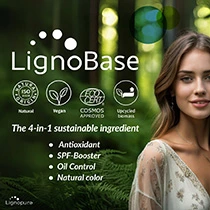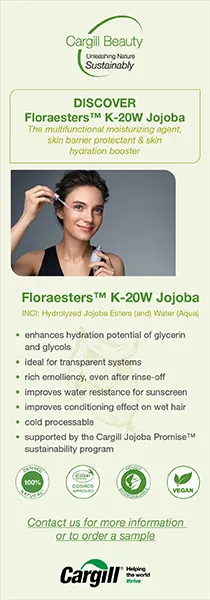Cosmet’Agora 2025: BASF highlights rise in climate-adaptive beauty trends

BASF attended Cosmet’Agora 2025, in Paris, France, on January 14–15 and revealed an innovative formulation that taps into the consumer trend for climate change-adaptive skin care. The concept introduces eco-conscious, climate-adaptive formulations for hydration, cleansing, UV protection and natural makeup.
Cosmet’Agora 2025 is an International trade exhibition that offers industry professionals the chance to discover what’s new and trending in cosmetic formulation, from raw materials to technologies. It also provides the opportunity to meet with insiders at the forefront of innovation, including R&D laboratories and regulatory experts.
Rising temperatures and poor air quality are driving consumer demand for skin care products that can adapt and offer protection against these changing conditions. BASF’s featured formulas are said to “meet the needs of eco-conscious consumers while addressing challenges in personal care.”
Valérie Pian-Parison, senior marketing manager, France, says, “At BASF, we take our responsibility seriously. We contribute to the Sustainable Development Goals with eco-conscious solutions, and we care about consumer needs for new beauty routines.”
Personal Care Insights has followed BASF’s recent eco-conscious innovations, reporting in December that the company and Innovative Oil and Carbon Solutions signed an agreement to develop and supply the chemicals company with environmentally sustainable macaúba oil for its Personal and Home Care portfolio in Brazil and Europe.
Formulas driven by sustainability and science
BASF highlights that as climate change increases variability in humidity, temperature and UV exposure, the demand for customized personal care products is growing. This demand has encouraged the chemicals company to develop climate-adaptive beauty routines based on four key themes: Hydrating & Cooling, Cleansing & Protection, UV Protection and Optimistic Glow.
The first set of formulas (Cetiol Ultimate, Cetiol iSan) and natural-origin emulsifiers (Emulgade Verde 10 MS and 10 OL), focuses on transepidermal water loss and offer an immediate moisturizing effect. Meanwhile, skin cleansing formulas (Lamesoft PO65) and hair formulas, (Gluadin Kera P-LM) create a protective barrier by utilizing mild, readily biodegradable alternatives to sulfate surfactants.
 Climate changes are causing the personal care industry to change with them.BASF has also developed eco-friendly sun protection solutions offering broad-spectrum UV protection (Tinomax CC, Tinosorb A2B, Uvinul TS Hydro) with oils and emulsifiers from natural origins.
Climate changes are causing the personal care industry to change with them.BASF has also developed eco-friendly sun protection solutions offering broad-spectrum UV protection (Tinomax CC, Tinosorb A2B, Uvinul TS Hydro) with oils and emulsifiers from natural origins.
The last theme appeals to eco-conscious beauty consumers searching for natural makeup solutions with skin tone-inspired shades and bolder color options for the eyes and lips. The ingredients come from renewable feedstocks (Cosmedia Gel CC, Cosmedia DC, Verdessence Alginate, Xanthan and RiceTouch).
Climate adaptive beauty: A growing trend
The premise of climate-adaptive skin care is simple. A different climate requires different skin care formulations and as consumers become more aware of the effects of climate change on their health, they are actively seeking products that help to protect and improve their skin.
Personal Care Insights previously reported on the rise of the climate-adaptive beauty trend and how it marks a huge opportunity for brands to set themselves apart from competitors on the market.
According to a report by Innova Market Insights on global climate change in beauty and personal care, 2024 saw an increase in customer awareness of how weather extremes are connected to climate change and the need for brands to address these impacts.
While anti-pollution skin care has been around for years, beauty brands are going one step further and responding to changing environmental conditions with innovative climate-adaptive products that protect the skin from growing concerns such as frequent heatwaves, humidity spikes and increased UV radiation.
Innovative hair care formulations are another area that could see development, as explained by Innova Market Insights global insights director Lu Ann Williams: “You are going to notice if your hair is frizzy six months out of the year versus two months out of the year. If someone makes a new conditioner that helps you address these changes, you are interested.”













